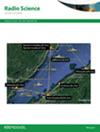Examining the power law relationship between absorption and frequency using spectral riometer data
IF 1.5
4区 地球科学
Q3 ASTRONOMY & ASTROPHYSICS
引用次数: 0
Abstract
High frequency radio wave propagation is sensitive to absorption in the D and lower E-region ionosphere. Absorption models typically characterize attenuation expected at 30 MHz, meaning scaling relationships are required to map to absorption expected at other frequencies. This is important when evaluating absorption at <20 MHz, as these frequencies are typically used for communication, and are highly sensitive to ionospheric disturbances. Typically, a power law relationship between absorption and frequency with a coefficient of n = − 2 is used. This relationship can be demonstrated through consideration of the Appleton-Hartree equation. This paper examines the performance of this relationship using data from the Kilpisjärvi Atmospheric Imaging Receiver Array for 13–14 November 2012. Using absorption measured at 30 MHz as a baseline, the power law relationship was used to calculated absorption at frequencies of 10–80 MHz. For this event, the power law relationship performed well when the measured absorption at 30 MHz was <1–2 dB, but strongly overestimated measurements as absorption increased. Performance improved when n was allowed to vary as a function of the overall level of absorption at 30 MHz. This accounts for local ionospheric changes associated with absorption events that change the balance of parameters in the Appleton-Hartree equation causing deviation from n = − 2. To further accommodate deviations associated with both local ionospheric disturbances and ambient electromagnetic noise contributions, an empirical relationship relating the logarithm of absorption to frequency was evaluated as a function of overall absorption. Compared to the simplified n = − 2 power law relationship between absorption and frequency, the new relationship better represents measured absorption for the event studied.利用光谱里程计的数据检验吸收和频率之间的幂律关系
高频无线电波的传播对D区和低e区电离层的吸收很敏感。吸收模型通常表征30mhz预期的衰减,这意味着需要缩放关系映射到其他频率的预期吸收。这在评估<20 MHz的吸收时很重要,因为这些频率通常用于通信,并且对电离层干扰高度敏感。通常,吸收和频率之间的幂律关系的系数为n = - 2。这种关系可以通过考虑Appleton-Hartree方程来证明。本文利用Kilpisjärvi大气成像接收机阵列2012年11月13-14日的数据考察了这种关系的表现。利用在30 MHz测量的吸收作为基线,幂律关系用于计算10-80 MHz频率的吸收。对于该事件,当30 MHz处测量的吸收< 1-2 dB时,幂律关系表现良好,但随着吸收的增加,测量值被严重高估。当允许n作为30mhz的整体吸收水平的函数变化时,性能得到改善。这解释了与吸收事件相关的局部电离层变化,这些变化改变了阿普顿-哈特里方程中参数的平衡,导致偏离n = - 2。为了进一步适应与局部电离层干扰和环境电磁噪声贡献相关的偏差,将吸收对数与频率的经验关系作为总吸收的函数进行了评估。与简化的n =−2幂律吸收与频率关系相比,新关系更好地代表了所研究事件的测量吸收。
本文章由计算机程序翻译,如有差异,请以英文原文为准。
求助全文
约1分钟内获得全文
求助全文
来源期刊

Radio Science
工程技术-地球化学与地球物理
CiteScore
3.30
自引率
12.50%
发文量
112
审稿时长
1 months
期刊介绍:
Radio Science (RDS) publishes original scientific contributions on radio-frequency electromagnetic-propagation and its applications. Contributions covering measurement, modelling, prediction and forecasting techniques pertinent to fields and waves - including antennas, signals and systems, the terrestrial and space environment and radio propagation problems in radio astronomy - are welcome. Contributions may address propagation through, interaction with, and remote sensing of structures, geophysical media, plasmas, and materials, as well as the application of radio frequency electromagnetic techniques to remote sensing of the Earth and other bodies in the solar system.
 求助内容:
求助内容: 应助结果提醒方式:
应助结果提醒方式:


